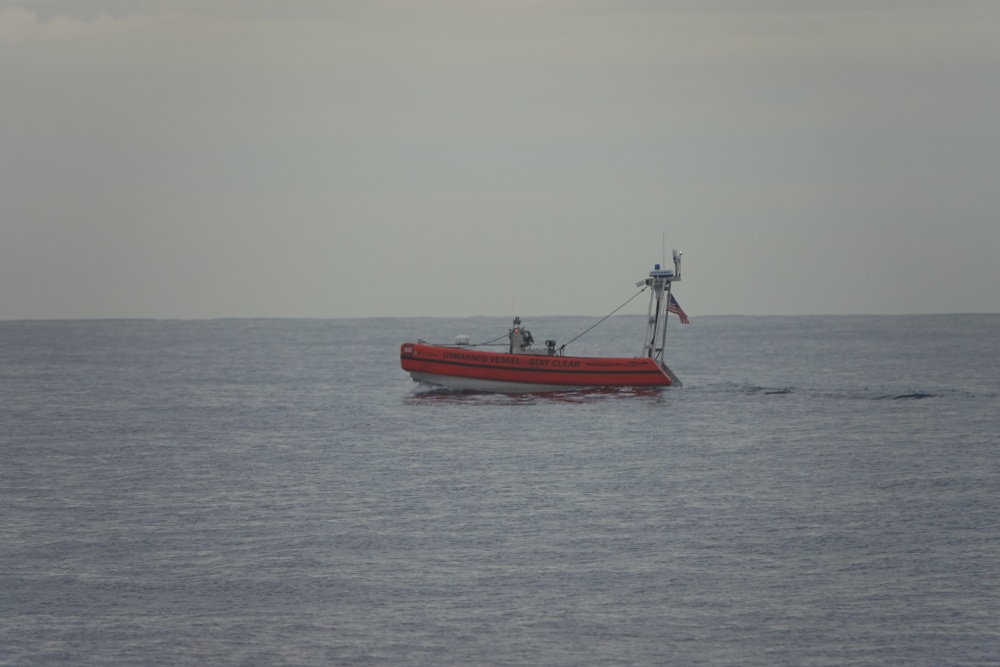The Coast Guard recently completed a 30-day test of unmanned surface vehicles (USVs) off Oahu.
“It’s clear that autonomous technology is a growing industry, and has great potential to enhance Coast Guard operations,” said Cmdr. Blair Sweigart, the demonstration’s director from the Coast Guard Research and Development Center (RDC). “Combined with artificial intelligence algorithms, unmanned systems could be a game changer.”
 The pilot test focused on Unmanned Surface Vehicles (USVs) from Saildrone and Spatial Integrated Systems.
The pilot test focused on Unmanned Surface Vehicles (USVs) from Saildrone and Spatial Integrated Systems.
The RDC also purchased its own 29RDC – which shares the same hull as the RBS-II from Metal Shark – and configured it to host an autonomous control system from Sea Machines in Boston, MA.
The updated 29RDC can be operated using a waist-mounted remote control or autonomously with a laptop. “It was a blast to drive,” said BM1 Houston C. Riley, who participated in the pilot study.
“As a Boatswain’s Mate, I was interested in just how a USV would be valuable to everyday operations,” said Riley, a boat driver with MSST Honolulu. He was particularly curious to see how a USV might help with Enforcement of Laws and Treaties (ELT), Recreational Boater Safety (RBS), SAR, and Counter Drug Alien Migrant Interdiction Operations (CD-AMIO).
“The first application that was immediately apparent was the utilization of the USV as a force multiplier from a cutter or shore unit. Having another asset on scene to assist as a show of force or presence is invaluable to the CG's law enforcement missions,” Riley said. “During an event like the Fourth of July, or a regatta, you can leave it unmanned or have someone operate the vessel remotely, to keep people at bay or create an atmosphere of safety. It has video cameras on it, so the operator or someone back on shore  could have that visual input.”
could have that visual input.”
The Coast Guard’s Strategic Plan 2018-2022 calls on the service to evaluate emerging technologies such as unmanned platforms, artificial intelligence, machine learning, network protocols, information storage, and human-machine collaboration.
These tests represent a commitment to those goals, allowing the Coast Guard to identify how USVs might support search and rescue operations, improve marine environmental response, enhance port security, aid in the fight against illegal maritime smuggling, and identify vessels engaged in illegal, unreported, and unregulated fishing.
“What I really found interesting was using the USV as a manned vessel for SAR ops. As the USV ‘self-operates’ on a search pattern, the operators are freed to keep a lookout for a person in the water or vessel,” Riley said. “Additionally, the USV has a sea-keeping ability an d will account for the prevailing wind and seas, easing crew fatigue and the potential for mishaps.”
d will account for the prevailing wind and seas, easing crew fatigue and the potential for mishaps.”
With their long endurance, USVs can provide persistent domain awareness in remote regions of the U.S. Exclusive Economic Zone. By conducting the demonstrations off Hawaii, the teams gained a firsthand understanding of how these assets could help protect the islands, and the critical resources and habitats throughout Oceania.
“The demonstration helped us understand what these technologies currently are - and are not - capable of,” said Sweigart. “These vessels proved to be very effective across a variety of mission areas. The results of this study will help shape how the Coast Guard, and our partners, potentially incorporate USVs into our future operations.”
During the tests the Coast Guard worked closely with NOAA, DHS partners, the U.S. Navy, and agencies from several partner nations who frequently join in protecting the global maritime and fishing industries.
Preliminary results can be found in this public quick-look report. A full report will be released next year.
Resources